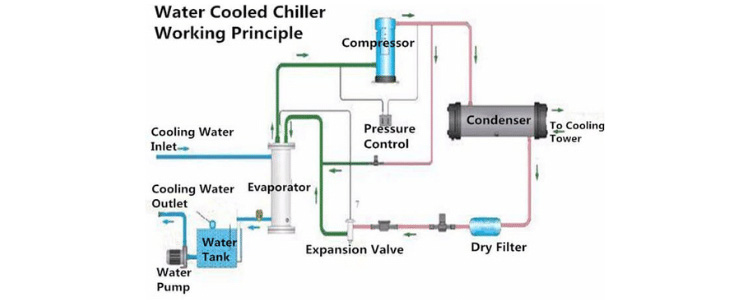Chilled water systems are used in medium and large-sized buildings. Chiller plants act as a centralized cooling system that provides cooling for an entire building or even multiple buildings. This is because it is often more practical to centralize air conditioning equipment in one location rather than install many pieces of equipment in many different places.
Chilled water reset—raising and lowering
Many chilled-water plants use chilled water reset, that is, the chiller’s leaving water temperature set point, in an effort to reduce chiller energy consumption. This can either be accomplished by the chiller controller or by the system controller. Raising the chilled-water temperature reduces chiller energy consumption. In a constant-volume pumping system, this may reduce overall system energy consumption as long as humidity control is not lost. Humidity control may be lost if, as chilled-water temperature is increased, the air temperature leaving the coil increases to a point where it no longer performs adequate the humidification.
In a variable-volume pumping system, however, raising the water chiller suction temperature increases pump energy, often substantially, and typically increases total system energy. Before considering increased chilled-water temperature, the system operator should calculate the increased pumping energy and compare it with the chiller energy savings.
An often overlooked method of decreasing system energy consumption is to reduce the chilled-water temperature, thereby decreasing pumping energy but increasing chiller energy. This strategy is possible with adequate chiller capacity and lift capability. Reducing water chiller temperature may also improve the humidification in the building. Another result of reducing the chilled-water temperature is increased chiller capacity during times when the condenser water temperature is cooler than design. This allows more time before another chiller and its ancillary equipment are started.
Be aware that any change in chilled-water set point requires changes to be made to the system chiller-sequencing algorithms to ensure that system capacity is met. This added complication may not be warranted.
Chilled-water pump control
In constant flow systems, the pumps are either on or off, providing relatively constant flow when turned on. In practice, some flow variation will occur as system pressure drop changes. In a variable-flow system, pump control is most often performed by maintaining a pressure differential at a selected point in the system. For example, a variable-speed drive will increase its speed if the sensed pressure differential is too low, or slow down if the pressure differential is too high. The control point is selected to minimize over-pressurizing the system and to assure adequate flow at all critical loads.

